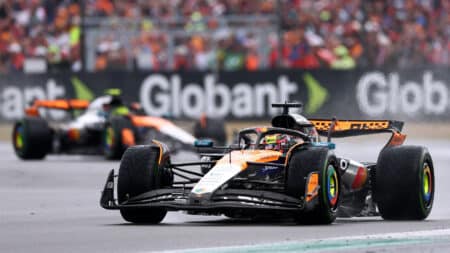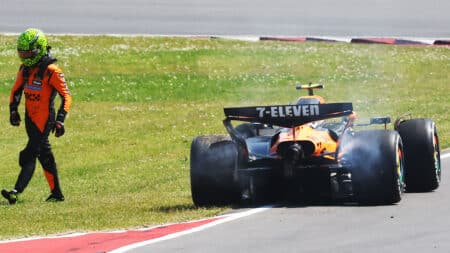
Norris was lucky, Piastri was better driver – British GP Up/Down
Was Oscar Piastri the real winner in the long run after Silverstone? asks James Elson
I like this time of year. New racing cars break cover, their teams and drivers full of hope that potential shored up during winter will spring into reality as testing programmes swing into action.
By now Fernando Alonso and Sebastian Vettel will have an inkling what they have let themselves in for after first runs for their respective new teams at the Jerez Formula 1 test. Alonso’s day was heavily truncated in a stuttering start to life at McLaren-Honda, while Vettel enjoyed better fortunes at Ferrari. A slow start caused by telemetry problems was followed by fastest time of the day in the afternoon.

Nothing to get excited about, of course, Ferrari itself quick to remind us that Kimi Räikkönen managed exactly the same feat on his return to the team this time last year – and we all know how that turned out. It’s something of a mantra in motor racing that testing times, especially at this early stage, mean zip all.
Still, drivers always say those first initial moments in a new racing car are enough to know what they’ve got for the year. I always remember Jenson Button speaking of his dismay when first encountering the dog of a Honda he flogged around the world’s circuits during 2008, then the entirely opposite sensations he savoured a year later after his first miles in the Brawn-Mercedes. From the precipice of F1 oblivion a few months earlier he’d suddenly found himself in a car he immediately knew could change his life. And it did.
The novelty factor of new car and driver combinations always creates a buzz, but in an era when even Adrian Newey admits he’d struggle to tell the difference if all F1 machines were painted white there’s only so much to get excited about. Camouflage liveries are a bit of fun, but nothing more.
In contrast, we’ve had a glimpse of something truly different, outlandish and thought provoking courtesy of sports car racing. Nissan’s GT-R LM NISMO has been the most anticipated racing car launch of the winter, and sure enough it didn’t disappoint when the Japanese manufacturer chose to give first sight to the humungous Super Bowl TV audience in the US. Presumably, this odd-looking contraption that’ll take part in a race most American football fans won’t have heard of was greeted by millions of furrowed brows across the nation. Still, I’m sure the sheer number of eyeballs will allow the marketeers to justify the cost for such a prime time slot.

This launch didn’t have the surprise factor of, say, the six-wheel Tyrrell P34 which famously caught everyone on the hop when the covers came off (literally, not figuratively) nearly 40 years ago. Grainy footage of a test at Austin’s Circuit of the Americas supported strong rumours of a front-engined hybrid that would ensure a clear distinction from the rival LMP1 designs of Porsche, Audi and Toyota, and so it has proved.
The GT-R features a front-mounted conventional 3-litre V6 twin turbo mated to a kinetic energy recovery system (ERS) that drives the front wheels. Nissan is going all-out for power with this car, entering the top 8MJ class of LMP1. The pay-off for that push (or rather pull…) is of course a smaller fuel allocation, requiring incredible efficiency from the V6.
Placing the engine ahead of the cockpit has shifted the weight bias to maximise traction from the front-wheel-drive powertrain, promising explosive acceleration that designer Ben Bowlby has likened to “a stick of dynamite”. The driven wheels will turn on conventional 14-inch Michelins like Nissan’s rivals to make the most of that power, but the switch in dynamics means the rears are just nine inches in foot print width.
It’s exactly the unconventional alternative racer we’ve come to expect from Bowlby, the man behind the DeltaWing and Nissan ZEOD RC that raced from Le Mans’ ‘Garage 56’ for highly innovative vehicles two years ago.

Oh, and I probably don’t need to point it out, but… the GT-R wouldn’t win many votes at Pebble Beach. Then again, Marc Gené, the first driver confirmed in the team for this year, won’t care how it looks if it works. The Spaniard will be well placed to compare unconventional to ‘normal’ thinking having switched from Audi.
So can Nissan really beat the might of Porsche, Audi and Toyota with something so off the wall? Well, certainly not straight away, but then no one would expect the team to win Le Mans in its first year with even the most conservative design concept. But beyond this year…?
NISMO president Shoichi Miyatani has spoken of bettering Nissan’s record of third place at Le Mans – achieved by Kazuyoshi Hoshino, Masahiko Kageyama and Aguri Suzuki in the TWR-developed R390 GT1 back in 1998 – and even went as far as to state: “We want to win and we have the knowledge to do that.” Meanwhile in Bowlby, it has a vastly experienced racing car designer who is utterly convinced that his philosophies can be genuinely competitive.
But the message at this launch was predominantly about innovation and the transfer of technology back to the road. As the Super Bowl ad shows, the ‘message’ is of primary importance to Nissan in its daily war with Toyota and Honda for car sales. Such emphasis makes you wonder if victory at Le Mans is the ultimate target of this particular programme, and if it isn’t that’s another aspect which separates Nissan from its racing rivals at Porsche, Audi and Toyota.

Whatever, Motor Sport of all publications isn’t about to cast too much cynicism on a racing programme that is so ambitious in its scope. Nissan’s example proves yet again that sports car racing trumps F1 as the true breeding ground for technical innovation in racing, offering a set of rules that allows freedom of expression among the four giants contesting its top class.
We hope the GT-R ‘explodes’ in the manner Bowlby intends it to.
Le Mans is never far from the pages of Motor Sport and this month the magazine recalls 24 Hours past, with a particularly feline theme. Jaguar’s XJR-5 heads a quadruple test as our cover story, pulling along a group of cars best described as ‘cult classics’ from the manufacturer’s racing linage. The 1950s and late ‘80s/early ’90s are rightly remembered as the most significant years of competition for Jaguar, but the ’70s and early ’80s had their high points too.
Bob Tullius’s place in Jag folklore is secure thanks to his Corvette-slaying feats in the Group 44 E-type, and he cemented his historical significance by taking the manufacturer back to Le Mans a few years later with our featured XJR-5. Tom Walkinshaw Racing took the story on, of course, but first sharpened its claws with the glorious XJS in European touring cars and at Bathurst. These important cars paved the way for the glories to come.

And the fourth car in our group? Well, in true British Leyland style the monstrous XJC promised so much and delivered a disaster. But how gloriously so. As he tells Andrew Frankel in our story, John Fitzpatrick will always defend the car that was always plenty quick enough – if only it could have been made to last the distance.
Elsewhere, Simon Taylor meets another Jaguar legend as he lunches with 1988 Le Mans winner Jan Lammers this month; Mark Hughes digs at the roots of F1’s current cash crisis; and editor-in-chief Nigel Roebuck recalls an old interview with Raymond Mays on another ‘glorious British failure’, perhaps the most infamous of them all – the BRM V16. Motor racing is as much about losing as winning, and often those stories can be more compelling…
Speaking of other reasons to draw you in, there’s an extra supplement this month to as we present our 2015 Historic Racing Guide, produced in association with our friends at Credit Suisse. All you need to know about the rich variety of the historic racing scene will be at your fingertips – even for overseas readers. A digital version for iPad and Android devices is also available beyond the print edition. We hope you enjoy it.

Was Oscar Piastri the real winner in the long run after Silverstone? asks James Elson

Lewis Hamilton hadn't won in almost three years – and then produced a sensational victory at Silverstone 2024. James Elson explains why it was his best ever

Describing this year's championship race as a 'battle' might be slightly over-egging it, writes James Elson

Lando Norris's wrecked McLaren was some metaphor for his racing aptitude over the last 12 months